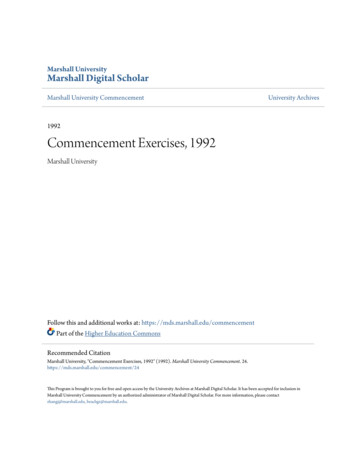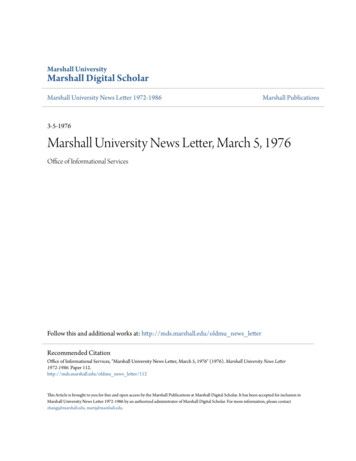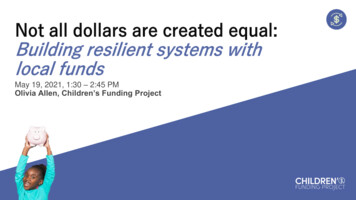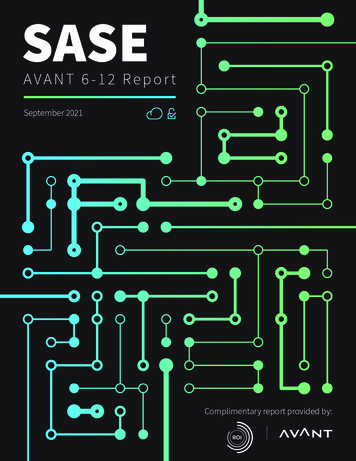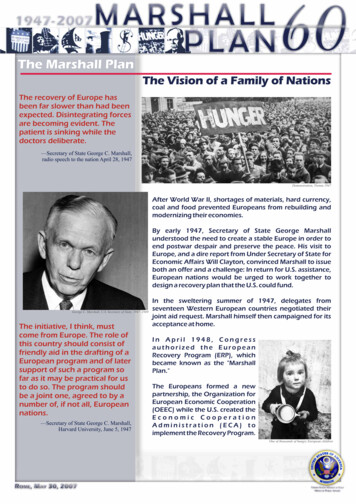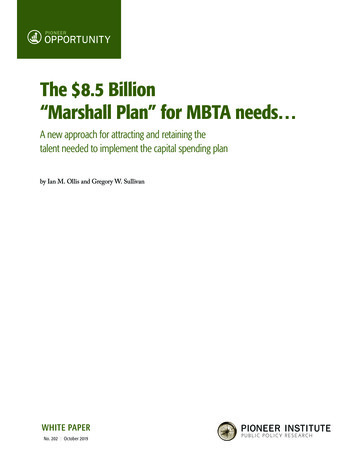
Transcription
The 8.5 Billion“Marshall Plan” for MBTA needs A new approach for attracting and retaining thetalent needed to implement the capital spending planby Ian M. Ollis and Gregory W. SullivanWHITE PAPERNo. 202 October 2019
PIONEER INSTITUTEPioneer’s MissionPioneer Institute is an independent, non-partisan, privately funded research organization thatseeks to improve the quality of life in Massachusetts through civic discourse and intellectuallyrigorous, data-driven public policy solutions based on free market principles, individual liberty andresponsibility, and the ideal of effective, limited and accountable government.This paper is a publication of Pioneer Opportunity, which seeks to keep Massachusetts competitive by promoting a healthy business climate,transparent regulation, small business creation inurban areas and sound environmental and development policy. Current initiatives promote market reforms to increase the supply of affordablehousing, reduce the cost of doing business, andrevitalize urban areas.Pioneer Health seeks to refocus the Massachusetts conversation about health care costs awayfrom government-imposed interventions, towardmarket-based reforms. Current initiatives includedriving public discourse on Medicaid; presenting a strong consumer perspective as the stateconsiders a dramatic overhaul of the health carepayment process; and supporting thoughtful tortreforms.Pioneer Education seeks to increase the education options available to parents and students,drive system-wide reform, and ensure accountability in public education. The Center’s workbuilds on Pioneer’s legacy as a recognized leaderin the charter public school movement, and asa champion of greater academic rigor in Massachusetts’ elementary and secondary schools.Current initiatives promote choice and competition, school-based management, and enhancedacademic performance in public schools.Pioneer Public seeks limited, accountable government by promoting competitive delivery ofpublic services, elimination of unnecessary regulation, and a focus on core government functions. Current initiatives promote reform of howthe state builds, manages, repairs and finances itstransportation assets as well as public employeebenefit reform.Pioneer Institute is a tax-exempt 501(c)3 organization funded through the donations of individuals, foundations and businessescommitted to the principles Pioneer espouses. To ensure its independence, Pioneer does not accept government grants.
THE 8.5 BILLION “MAR SHALL PL AN” FOR MBTA NEEDS Table of Contents1. State of Capital Projects 42. M BTA just doesn’t have the peopleto achieve the aggressive new targets 53. A cquiring the talent for the job 63.1 A new approach to projects 63.2 Addressing hiring difficulties 84. C onfusing leadership & management structure 85. Unbalanced workload 86. B etter HR plan and management structure arerequired to meet much larger budget targets 87. Structure for Capital Projects and Maintenance 98. Key talent recruitment 108.1. Appropriate senior salary scales 108.2. Reduce length and complexity of hiring procedures 108.3. Monitoring of the staffing complimentof the Capital Investment Plan rollout 119. City to Regional Co-operation 11Conclusion 113
THE 8.5 BILLION “MAR SHALL PL AN” FOR MBTA NEEDS Let’s start with the good news for the MBTA. The Governor and the Massachusetts Legislature have committed over 8.5 billion to repair and modernize the T between fiscal years2020 and 2024. Now, the bad news. If the past is prologue, theT currently has nowhere near the capacity to spend that much.This paper is an urgent call to put all options on the table tomeeting the challenge, including models for accomplishingthe work but with a special focus on acquiring the talent todo the work.As Pioneer recently reported in a paper on capital spending entitled “The MBTA’s Capital Spending Crisis,” the T hashistorically struggled severely when its capital spending budget was increased dramatically.1 It is one thing to approve acapital budget on paper for 1.6 billion per annum, but quiteanother to actually execute on that volume of projects.Back in 2001, when the MBTA budgeted 250 million inannual capital expenditures, it was generally able to achieve atleast a 90 percent spend rate. But when, in 2009, the budgetwas hiked to meet the goal of spending an annual average of 750 million over the five-year plan starting that year, it tookthe T four years to ratchet up its capacity to approximate thatnew objective.Unsurprisingly, a key element in achieving a dramatically higher spend rate is attracting and retaining professionalexpertise in capital delivery.The problem with the MBTA capital program is not a lackof money, but the ability to spend it. The MBTA suffers from ahiring crisis and has had great difficulty attracting the best andbrightest in key positions, with the result that some positionshave remained vacant for extended periods of time. Cumbersome hiring policies are part of the reason for a shortage ofcritical skills that prevent the T from ramping up rollout of thecapital investment projects needed to meet significant infrastructure shortcomings.This paper makes recommendations that will ramp upthe deployment of the right talent in the right positions. Ourultimate objective is to significantly increase capital investment delivery. Revitalizing the MBTA will require five majorchanges that amount to a Marshall Plan for hiring and contracting — better hiring practices, improved internal organization, strategic use of external expertise, appropriate procurement models and city-to-regional co-operation. Nothingless will get the MBTA riders the modernization of transitservices they need.1. State of Capital ProjectsThe MBTA has suffered from underspending on capitalprojects and the effects of this can be seen in the poor stateof repair of the Red, Orange, Blue and Green Lines andcommuter rail, recent derailments, fires, and long delays.Management has ramped up capital spending targets, buthas a long way to go to achieve a state of good repair andmodernize the system. The graph below illustrates theunderspending of capital budgets.Figure 1. Actual spending in Millions versus the Budgeted 2020–2025 Capital Spending 2,000 1,500Projected Spending2019 in Millions 1,000Good RepairRequired Spend With‘Rail’ in Millions 500Good Repair RequiredSpending in Millions0010203040050607080910111213141516Fiscal YearSource: MBTA Audited Financial Statements417181920210222324Current Spendingin Millions
THE 8.5 BILLION “MAR SHALL PL AN” FOR MBTA NEEDS In “The MBTA’s Capital Spending Crisis,” Pioneer Institute mentioned the onerous legal obstacles tospeeding up capital delivery, such as the filed sub-bid law. The MBTA is required to conduct a separatetrade contractor selection process for 18 types of sub-contractors when the it uses Construction Manager atRisk contracts (M.G.L c 149A). Furthermore, state law prohibits the MBTA from using Design-Build andConstruction Manager-at-Risk project delivery methods for contracts of less than 5 million. Most otherstates do not place dollar values on alternative project delivery methods.The real solution is put the MBTA on a similar (and shorter) procurement footing as other U.S.transit agencies. The state Legislature should allow the MBTA to use any Federal Transit Agency-approved standard procurement procedures for transit agencies with approval of the Massachusetts Inspector General, which would achieve this.The table below puts the capital spending problem in stark relief. We have looked at the five-yearplans and translated the average amount budgeted for in each five-year into an average annual target.We then compared this number to the average annual spend over the CIP period for each of theseCIPs for each of these years to show how spending has been falling behind.Figure 2. MBTA Average annual budget versus average annual spend. 2,000 1,500 1,000 500Average annualspend rate budgetedin 2324Fiscal YearSource: MBTA Audited Financial Statements2The MBTA clearly has a problem meeting capital expenditure targets. Part of the reason is that internal staffing, management and internal structural limitations make procurement excruciatingly difficult. All this can be overcome, however, with the correct plan to attract and retain the correct people.Cooperation of all at the MBTA and MassDOT is needed to meet the challenge of modernizing theMBTA. A sense of ownership and community will go a long way, but some key interventions will beneeded to ramp up delivery.2. M BTA just doesn’t have the people to achieve the aggressive new targets.In “The MBTA Capital Spending Crisis,” we pointed out three massive jumps in spending targetsthat were followed by lags of several years before the T could ramp up capital expenditures. Theselags were caused by not having capital delivery staff and internal systems that were sufficient to meetthe targets.5Average annual spentduring CIP period
THE 8.5 BILLION “MAR SHALL PL AN” FOR MBTA NEEDS infrastructure. Other transit agencies, other state agenciesand big infrastructure companies have used alternative modelsto get projects done more quickly that will be helpful to theMBTA and will fill those gaps. Management should look atsolutions utilized by other successful agencies.In 2003, the National Highway Research Program, inconjunction with the Transportation Research Board, published a paper dealing with the practice of outsourcing whereit makes sense:What is new is that some state DOTs have begun tooutsource their capital program delivery functions,e.g. major facility designs and related PS&E (plans,specifications, and estimates) production, major project construction supervision, and comprehensive, longterm major area or system maintenance functions Although most states retain overall ultimate management responsibility of the delivery process, some arebeginning to consider delegating some of that responsibility as well.5In comments made to Boston 25 News, it was clear thatMBTA leadership recognizes the staffing problem:Steve Poftak, who took over as head of the MBTA inJanuary, told the authority’s oversight board Mondaythat the figures outlined in the existing five-year capital investment plan — a 66 percent jump in spendingfor expansion, reliability and modernization project —is ‘not something the MBTA will be able to execute.’3Instead, he suggested a new model with smaller butsteady annual increases for those categories. Thechange would give the MBTA time to add the staffand capacity needed to spend at least 1.5 billion peryear on maintenance by fiscal year 2024, officials said,and bring the entire transit system up to a state of goodrepair by 2032. That’s the spending that is going torebuild the system and create a reliable and dependableMBTA that we want to run.By focusing on the wholefive years and, in fact, the whole 15 years, it could meanyou don’t spend as much this year, but you get thosecontracts in place and those studies in place so we’reramping up.” 4In April 2019, a report by the Federal Highway Administration’s Office of International Programs entitled “Construction Management Practices in Europe and Canada” laysout the staffing issues being experienced internationally withregard to construction and project management:Historically, agencies have maintained design andconstruction administration staff in-house to ensurequality design and construction. However, increasingindustry demand for engineers and technicians, morecompetition for workers, a large number of retirements,the need for broader skill sets, and different expectations of young engineers are making it difficult forsome agencies to maintain an appropriate staffing level.(FHWA 2003).The MBTA currently has around 6,200 employees, buthas a number of key vacancies that stretch back a number ofyears. Poftak recently hired a head of capital projects and hashighlighted the 80 to 90 key vacancies he is attempting to fillto ramp up capital project delivery. This new appointment isclearly a step in the right direction.However a number of key vacancies pre-date Poftak andwere a challenge for his predecessors to fill. For the T to fulfillits capital spending mandate will require a number of additional highly skilled professionals with construction experience, and perhaps a new approach to these capital projects isrequired.U.S. transportation agencies are shifting methodology, withmuch of the planning, design, and construction work beingoutsourced. This is as much a trend intransit agencies as in highway departThese lags werements.caused by not havingFigure 3. provides a useful summacapital delivery staffry from the Federal Highway Authority report. The column on the left listsand internal systemsplanning, design, and constructionthat were sufficientactivities, which traditionally haveto meet the targets.been done in-house. The remainingcolumns list the approximate amountof work outsourced to the private sector. The percentagesare only estimates provided by international highway agencyinterviewees, but they reflect the overall use of in-house staffversus consultants.3. Acquiring the talent for the jobThere are broadly two approaches to acquiring the talent toramp up capital delivery and service at the MBTA that areoutlined in this paper. The first is to take a new approach toprojects, particularly Capital Projects, but in some cases operations also. Broadly speaking this means finding an organization that already has the talent for a particular project orservice. The other broad approach is to hire the right talent,particularly senior talent needed at the T, deploy them inimproved internal structures and retain them over time.3.1 A new approach to projectsIt is clear that even with revamped hiring procedures andimproved internal structures there will still be gaps in what’sneeded to complete modernization of MBTA systems and6
THE 8.5 BILLION “MAR SHALL PL AN” FOR MBTA NEEDS Figure 3. Construction management outsourcing analysisOutsourcing ActivityOntarioGermanyDesign80–90% 30–100% 3 100%100% 470% %100%100%100%100%100%Construction Contract 0%8100%100%100%7England2 Scotland6The Netherlands FinlandSource: Federal Highway AdministrationSome international agencies use private consultants for some of the work, while others havealmost completely outsourced traditional state agency functions:Germany and the Netherlands are most like the United States in their approach to designand construction staffing. They maintain a higher level of in-house engineers to performdesign and construction administration. The Bavarian highway agency in Munich, Germany, performs about 30 percent of its design for interstates in-house and about 70 percentfor federal highways and state roads Germany also maintains its system with state staff,but it is the only country that still performs that function.6The Netherlands department is being downsized, but recognizes the need to maintain expertisefor technical aspects of the program such as for bridges and tunnels.England and Scotland are perhaps the most different from the United States in their use ofin-house staff. The Private Finance Initiative of 1991 and a series of other issues have ledthe Highways Agency in England to outsource 95 percent of its expenditures. It has only asmall engineering staff in-house, and has changed from the role of providing engineeringfunctions to overseeing them.6Closer to home, the Chicago Transit Authority (CTA) has used an outside project managementagency to roll out its Capital Investment Program. Historically service had deteriorated and theinfrastructure was old. The decision was taken to get outside expertise to handle system modernization. Chicago Transit Partners (CTP), a joint venture of three companies specializing in construction, engineering and design management: DMJM Harris, Inc. and Consoer, TownsendEnvirodyne Engineers, Inc., both of Chicago, and Kenny Construction Company of Wheeling,Ill was ultimately chosen to become the effective project manager and their contract has beenrenewed several times since 2005.7 It is an extraordinarily large project and they have been paidsignificant fees for their work. Since this program has rolled out, the authority has rebuilt over 40stations and added an additional three, among other advances. Winning accolades from the publicand the American Public Transit Association for much-improved service and reliability.8 In 2019CTP was again chosen to head up improvement projects for the CTA.To get projects completed, some large private firms have already retained skills the MBTAmay be struggling to recruit. To speed delivery, some projects are best handled by such firms, evenon the operational side in some instances.For its current projects, the MBTA should explore whether it would be desirable to outsourcesome of the project management and have only internal senior staff to oversee, inspect and signoff as the project unfolds, with external contracts including much of the project management.Some operations can be outsourced for efficiency gains. After a rough start, Keolis has recentlyimproved commuter rail service. However the full impact of outsourcing is probably not being feltin this case, as the equipment, infrastructure and staffing are largely the same that had been usedby the previous contractor. Some efficiency gains should result from the outsourced model alone,but with faster trains, better fare collection systems, fast boarding stations and a better-draftedcontract with Keolis, much more could be achieved. There may be other operational systems thatare currently not functioning well that may benefit from private expertise in cases where bringingon significant internal expertise is proving unachievable.7For its current projects,the MBTA shouldexplore whether itwould be desirable tooutsource much of theproject managementand have only internalsenior staff to oversee,inspect and sign offas the project unfolds,with external contractsincluding much of theproject management.
THE 8.5 BILLION “MAR SHALL PL AN” FOR MBTA NEEDS The MBTA has already brought in outside companies towork with in-house staff on important projects. Specialistswere brought in for the Green Line Extension, the Red Line/Orange Line Program office, and the Positive Train ControlProject to beef up the team’s efforts. However these teams stillhave to be managed by senior internal experts. This method,or even complete project outsourcing, should be used when itis the best fit.Poftak’s plan involves hiring another 80 full-time employees to focus on capital projects, bringing the staff up to thebudgeted level in that area, and a high-ranking official tooversee the programs.12 Chief of Capital Projects Jay Neiderwas hired in May 2019 and a process is underway to staff hisoffice13. However the timelines to fill the capital positions islikely to be too long to facilitate the required capital spendingincrease.3.2 Addressing hiring difficulties4. Confusing leadership & managementstructure.We should be asking why it has been so difficult to the talent necessary for the key positions the T so urgently needs.One of the problems is that thereare around 96 steps that have toWe should be asking whybe followed to hire a single perit has been so difficult toson at the MBTA. This is bornethe talent necessary forout by the Human ResourcesQuarterly Update presentedthe key positions the T soat the July 22, 2019 Fiscal andurgently needs. One of theManagement Control Boardproblems is that there arejoint meeting9. According to thearound 96 steps that havereport, it takes between 62 and145 days to complete these steps.to be followed to hire aUnion leaders need to work withsingle person at the MBTA.MBTA management to reducethe grind associated with gettingstaff hired. The laborious process prevents the T from operating at full capacity.The human resources department has announced a targetto reduce the 96 steps to 47. They could perhaps be furtherreduced, but 47 would certainly be a giant leap forward. Additionally, many of these remaining steps should be conductedsimultaneously to speed up the process. The MBTA urgentlyneeds to hire senior executive project managers, contract managers and other senior staff who can quantify problems andturn them into contracts that can be funded and let.A second problem is that advertised salaries for these positions are below industry norms for highly skilled positions.Senior project managers or engineers with multiple years ofreal world experience come at a premium, and the currentenvironment can prevent management from negotiatingaggressively to attract the talent needed to rapidly ramp upcapital delivery.Retaining or replacing good people is difficult at theMBTA. Bruce Mohl wrote in a revealing April 2019 article ofthe employee exodus: “According to numbers presented, . theT has hired 2,520 employees since 2015, but over that sametime period 3,052 employees have left the agency.”10 That represents almost half of the staff turning over in four years. “Thebiggest imbalance occurred in fiscal 2017, when a voluntaryretirement program was implemented and 348 employees werehired at the T and 746 left the agency.”11Senior MBTA leadership has acknowledged that T management structures are messy. Poftak said as much to the FMCB:“the T’s management structure is very confusing. He said 271of the 278 nonaffiliated (nonunion) management positionsat the agency have different titles. Transportation SecretaryStephanie Pollack seemed taken aback by the statistic, andasked (Matt) St. Hilaire ( the HR director) to confirm thenumbers were accurate. When he confirmed the numbers, shesaid: “That can be tough to manage.”14With complex reporting lines, progress slows, duplicationcan occur, or items fall off the radar. Take the Aquarium station on the Blue Line for example. Several years have gone bysince the decision to “weatherproof ” the subway station aftertwo storms severely damaged the elevators and escalators,which had to be replaced and rewired. Engineering reportsand plans to carry out the improvements needed to keep waterout of the station are apparently gathering dust at the MBTAoffices. This item should have been completed immediatelyafter the last major station flood, but it has not yet been done.When the next major storm again wrecks the access equipment, everyone will ask why the project hasn’t been completed.A simpler reporting structure, with predetermined roles andresponsibilities will make clear exactly who is responsible tocomplete each project.5. Unbalanced workloadPioneer institute is reliably informed that project managersoften simultaneously oversee many diverse projects, with somehandling up to 16 projects. If true, this results in a dilution offocus and may be one of the reasons why some projects get lostin the noise of the system. Clear reporting lines and realisticworkloads are a must.6. Better HR plan and management structureare required to meet much larger budgettargetsKey areas need attention to meet the increased capital spending included in the 2020–2024 Capital Investment Plan,8
THE 8.5 BILLION “MAR SHALL PL AN” FOR MBTA NEEDS plus additional maintenance funding Governor Baker hasannounced. While the current staff and systems have significantly increased spending in recent years, a much larger effortwill be needed to meet dramatically higher targets.process was eventually halted with approval of the Legislatureas the rationale for paying capital staff from the capital budgetbecame clear.In its fourth annual report to the Massachusetts Legislature, the Fiscal and Management Control Board wrote:Key areas that need restructuring: Clear internal structures for capital projects & maintenance Recruitment of key talent Appropriate senior salary scales Shorter, simpler hiring processes Because the Legislature agreed in the FY19 budgetthat some employees are appropriately paid from capital budget funds, the Authority will not complete thetransfer of all capital employees to its operating budget,reflecting this new guidance (see Section III C, below).In FY19, the Authority will implement a Capital Policy to further ensure capital and operating funds areused appropriately in the future.15Monitoring the filling of positions in the Capital Programsoffice.Limited project manager workloads for focused and speedyimplementationThis kind of messy restructuring, by shifting some people and then halting the process midway, is bad for moraleand speed of delivery. However it does establish the principlethat some capital project staff can be funded from the capitalbudget.When looking at the overall picture of senior staff, oneway to simplify the reporting lines and ensure sufficient seniorstaffing would be to populate a simple grid structure such asfigure 4 below. This would clarify how senior executive project management and engineering heads should relate to eachother. Individual project managers can then be linked to eachhead to clarify reporting lines and project responsibilities clarified. Implementing a structure like this will enable experienced senior project managers to focus on clearly delineatedresponsibilities with a clearly identified team of people whohandle each project.Hiring selected outside expertise to complement internalcompetenciesCollectively, these steps will reorganize internal structures,improve management and bring in much-needed new talent,which should be complemented by critical external skills.7. Structure for Capital Projects andMaintenanceSubsequent to the organizational review ordered by Governor Baker, staff were transferred from the capital to the operational budget to separate the two functions and prevent thefunding of operations from the capital budget. However thisFigure 4.Proposed MBTA projectdelivery structureDIRECTOR OF CAPITAL PROJECTS OFPowerSignal andCommunicationStations andFare CollectionBridgesand TunnelsRight of WayASS’T DIRECTOR OF CAPITAL PROJECTS OFVehicles- RED LINE CAPITAL PROJECTS- ORANGE LINE CAPITAL PROJECTS- BLUE LINE CAPITAL PROJECTS- GREEN LINE CAPITAL PROJECTSChiefChiefChiefChiefChiefChiefDeputy Chief(s)Deputy Chief(s)Deputy Chief(s)Deputy Chief(s)Deputy Chief(s)Deputy Chief(s)Chief EngineerChief EngineerChief EngineerChief EngineerChief EngineerChief sProjectsProjectsSignal ojectsProjectsStations andFare ProjectsBridgesand jectsRight of sNote: the MBTA often refers to Right of Way (ROW) as the Track Department.9- COMMUTER RAIL - BUS CAPITAL PROJECTS CAPITAL PROJECTS
THE 8.5 BILLION “MAR SHALL PL AN” FOR MBTA NEEDS Of course these new directors must be connected to theengineering and maintenance (E & M) people for their relevant competency. Capital project solutions must link to theongoing problems on the ground to ensure that the new workaddresses ongoing maintenance needs.Two MBTA job vacancies have recently been advertised,one for a project manager and another for a senior projectmanager. Below is a rough comparison from www.glassdoor.com and https://www.salary.com/ of commensurate salaryofferings in Boston.In addition, Pioneer is advocating for additional seniorexecutives above these levels to take charge of significant projects and lead the conversion of problems into projects in theChief Engineer’s office, in contract management to let contracts, and in project management to oversee project delivery.The use of capital dollars to fund this Marshall Plan would bejustified so long as the funds are used exclusively for capitalproject delivery.8. Key talent recruitmentCurrent project staff have done a great job of ramping up capital projects, but quickly growing from 900 million or 1billion annually to 1.6 billion will require a combination ofadditional internal and external expertise.Many problems at the MBTA are tied up in complex legalrequirements. However the hiring of senior management staffis not one of these. The Massachusetts Labor Relations Commission decision of December 7, 2000 excluded from collectivebargaining a significant number of T position titles includingthe terms chief, division chief, deputy chief, major sectionchief, deputy division chief, director, and assistant director,as well as several senior project manager and organizationalmanager positions. This allows the MBTA to appoint seniorpeople at negotiated competitive salaries in key positions needed to expedite urgently needed capital projects. Basically, theidea would be to have the T use the “exempt positions” rulingto hire experienced new capital project delivery staff from theoutside at market rates.16 All subsequent collective bargainingagreements have subscribed to this delineation of managerial jobs. Pioneer believes key executive level positions shouldbe created under the rulings, including ones in procurement,project management, contract management, engineering andproject design.The MBTA needs to recruit senior and experienced project managers, engineers, contract managers and the like tooversee the multitude of new repair projects that will improveservice at the T. As stated above, some of these positions canbe funded from the capital projects budget, as they will exclusively be rolling out capital projects. There are times when thisis
responsibility, and the ideal of effective, limited and accountable government. Pioneer Institute is a tax-exempt 501(c)3 organization funded through the donations of individuals, foundations and businesses committed to the principles Pioneer espouses. To ensure its independence, Pioneer does not accept government grants. Pioneer Education


